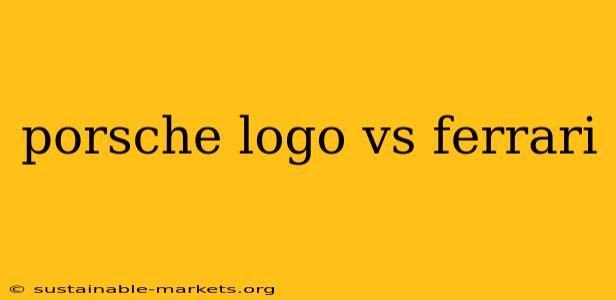The automotive world is a landscape of powerful brands, each with a unique identity forged in the fires of competition and innovation. Two titans of this world, Porsche and Ferrari, stand out not only for their performance but also for their instantly recognizable logos. While both represent speed, luxury, and heritage, their emblems tell vastly different stories. This comparison delves into the design, symbolism, and evolution of the Porsche and Ferrari logos, revealing the nuances that set them apart.
The Porsche Crest: A Story of Heritage and Location
The Porsche logo, a heraldic crest, is rich in symbolism reflecting the brand's origins in Stuttgart, Germany. Its key elements include:
-
The Black Shield: This forms the backdrop, providing a strong and stable foundation for the other elements. The black color suggests sophistication and power.
-
The Stuttgart City Coat of Arms: The leaping horse within the shield is a direct reference to the city of Stuttgart, where Porsche was founded. The horse, a symbol of power and strength, connects the brand to its roots.
-
The Antlers: Flanking the horse are antlers, representing the Württemberg region, further solidifying the connection to the brand's birthplace.
-
The Red and Black: The colors of the shield are those of the state of Württemberg, reflecting Porsche's deep connection to the region's history and heritage.
The Porsche logo, therefore, is more than just a pretty emblem; it's a carefully constructed visual narrative that anchors the brand to its origins and communicates a sense of heritage and tradition. Its relatively simple design has remained remarkably consistent over the years, highlighting its timeless appeal and brand recognition.
The Ferrari Prancing Horse: Speed, Power, and a Pilot's Legacy
In stark contrast to Porsche's grounded, heraldic design, the Ferrari logo is a bold and dynamic emblem. The key components are:
-
The Prancing Horse (Cavallino Rampante): The central and most iconic feature is the black prancing horse on a yellow shield. This is not just any horse; it's a symbol taken from the personal insignia of World War I Italian pilot Francesco Baracca, whose mother gifted it to Enzo Ferrari.
-
The Yellow Shield (Giallo): The bright yellow shield provides a vibrant backdrop that contrasts sharply with the black horse, making it instantly memorable. Yellow is also a prominent color in the Modena region of Italy, where Ferrari is based.
-
The Green, White, and Red Tricolour: Positioned above the shield, this is the Italian national flag, further emphasizing Ferrari's Italian heritage and national pride.
The Ferrari logo exudes speed, power, and a touch of aggressive flair. Its connection to a wartime hero adds an element of legend and daring to the brand identity. The evolving design variations, mainly in terms of detail and font, have been subtle, preserving the powerful essence of the original.
The Difference: Heritage vs. Heritage with a Touch of Legend
The key difference between the two logos lies in their approach to communicating heritage. Porsche's logo is a straightforward representation of its geographical origin and historical context. Ferrari's logo, on the other hand, incorporates a powerful narrative element—the legend of Francesco Baracca—adding a layer of mystique and drama. Both are effective in their own right, reflecting the distinct personalities and histories of these two automotive giants.
Conclusion: Beyond the Emblem, a Brand Identity
While their logos differ significantly in style and symbolism, both Porsche and Ferrari logos are powerful and instantly recognizable symbols of their respective brands. They represent not just cars but a lifestyle, an aspirational goal, and a rich legacy built on innovation, performance, and a deep connection to their respective regions. Understanding the history and symbolism behind these iconic emblems adds another layer of appreciation for these automotive giants.

